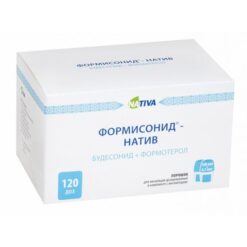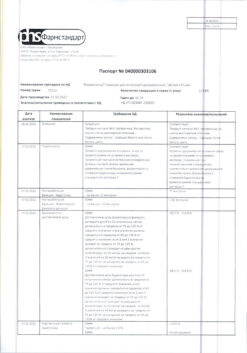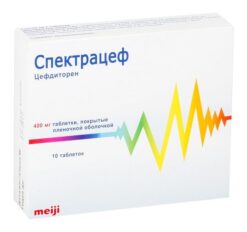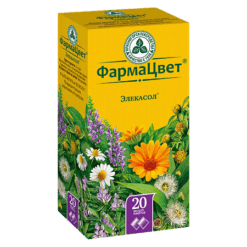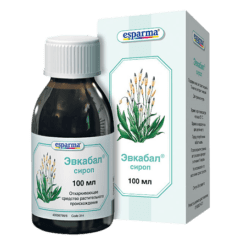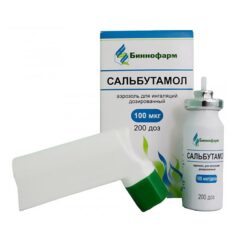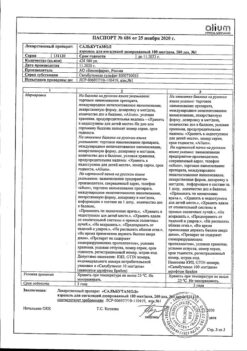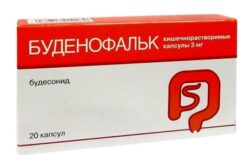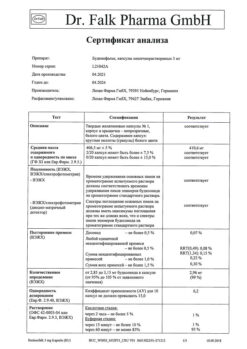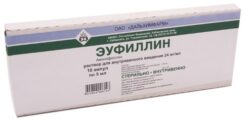No products in the cart.
Formisonide-Native, 320 mcg+9 mcg/dose 60 pcs
€1.00
Out of stock
(E-mail when Stock is available)
Description
bronchodilator combined (beta2-adrenomimetic selective + local glucocorticosteroid)
Indications
Indications
Active ingredient
Active ingredient
Composition
Composition
1 capsule contains formoterol fumarate dihydrate 12 mcg
Associates:
sodium benzoate – 0.02 mg,
Lactose monohydrate – up to 12 mg.
Composition of the capsule shell:
Caramel dye (E150c) – 1.4388%,
Hypromellose – up to 100%.
How to take, the dosage
How to take, the dosage
The drug is not intended to be taken orally. The dose of Formoterol-nativ is selected individually according to the needs of the patient. The lowest dose that provides therapeutic effect should be used. When achieving control of bronchial asthma symptoms during therapy with Formoterol Nativ, it is necessary to consider the possibility of gradual reduction of the drug dose. Dose reduction of Formoterol-nativ should be performed under regular medical supervision of the patient.
The drug is capsules with powder for inhalation, which should be used only with a special device – Inhaler CDM®, which is included in the package. Bronchial asthma The dose of Formoterol Nativ for regular maintenance therapy (12-24 mcg (contents 1-2 capsules) 2 times per day. Formoterol-nativ should only be used as adjunctive therapy to inhaled GCS. Do not exceed the maximum recommended dose of the drug of 48 mcg/day (contents of 4 capsules).
As the maximum daily dose of Formoterol Nativ is 48 mcg, if necessary, an additional 12-24 mcg/day may be used to relieve bronchial asthma symptoms. If the need for additional doses of Formoterol Nativ is no longer episodic (e.g. more than 2 days a week), this may indicate a worsening of asthma, you should consult a doctor.
Formoterol-nativ should not be started or the dosage of Formoterol-nativ should not be changed during an exacerbation of bronchial asthma. Formoterol-nativ should not be used to relieve acute attacks of bronchial asthma.
Prevention of bronchospasm caused by exercise or unavoidable exposure to a known allergen Formoterol-nativ should be used in a dose of 12 micrograms (1 capsule contents) 15 min before the intended exposure to the allergen or before exercise. Additional inhalations of the drug should not be carried out within the next 12 hours.
Prevention of severe bronchospasm Patients with a history of severe bronchospasm may require a single inhaled dose of 24 mcg (contents of 2 capsules). COPD The dose of Formotrol-Nativ for regular maintenance therapy of COPD is 12-24 mcg (contents of 1-2 capsules) 2 times daily.
Adolescents (12-17 years old):
Formisonide-nativ 80 mcg + 4.5 mcg and 160 mcg + 4.5 mcg 1-2 inhalations twice daily
Formisonide-nativ 320 mcg + 9 mcg 1 inhalation twice daily
Children over 6 years of age:
Formisonide-nativ 80 mcg + 4.5 mcg 1-2 inhalations twice a day.
Interaction
Interaction
Formoterol-Nativ, as well as other β2-adrenomimetics, should be prescribed with caution in patients receiving medications such as: quinidine, disopyramide, procainamide, phenothiazines, macrolides, monoamine oxidase inhibitors (MAOIs), tricyclic antidepressants, antihistamines, and other drugs known to prolong the QT interval, as in these cases the cardiovascular effects of adrenostimulants may be enhanced and the risk of ventricular arrhythmias increases.
The concomitant use of other sympathomimetic agents may worsen the adverse reactions of Formoterol Nativ. Concomitant use of xanthine derivatives, glucocorticosteroids or diuretics may increase the potential hypokalemic effect of Formoterol-Nativ. Patients receiving anesthesia with halogenated hydrocarbons have an increased risk of arrhythmias.
The drugs classified as β2-adrenoblockers may weaken the effects of Formoterol-on-tiv and lead to severe bronchospasm in patients with bronchial asthma. In this regard Formoterol topical should not be used with β2-adrenoblockers (including eye drops), unless there are some extraordinary reasons to use such a combination of drugs.
Special Instructions
Special Instructions
In patients with bronchial asthma Formoterol-nativ should be used only as adjunctive therapy when symptoms are not sufficiently controlled with inhaled GCS monotherapy or when the disease is severe and a combination of inhaled GCS and a long-acting β2-adrenoreceptor agonist is required. Formoterol-nativ should not be used with other long-acting β2-adrenoreceptor agonists.
When prescribing Formoterol-Nativ, the patients’ condition should be evaluated with respect to the adequacy of the anti-inflammatory therapy they receive. After initiation of treatment with Formoterol Nativ, patients should be advised to continue anti-inflammatory therapy without change, even if improvement is noted. β2-adrenoceptor agonists should be used to relieve an acute attack of bronchial asthma.
Patients should seek medical attention immediately if there is a sudden worsening of the condition. Hypokalemia A consequence of therapy with beta2-adrenomimetics, including Formoterol-nativ, may be the development of potentially serious hypokalemia. Hypokalemia may increase the risk of arrhythmias. Since this action of Formoterol-Nativ may be enhanced by hypoxia and concomitant treatment, special caution should be observed in patients with bronchial asthma of severe course. In these cases, regular monitoring of serum potassium concentration is recommended.
Paradoxical bronchospasm Like other inhaled drugs, Formoterol-nativ may cause paradoxical bronchospasm. In this case, the drug should be immediately discontinued and an alternative treatment should be prescribed. The use of formoterol in a dose exceeding 54 mcg/day (more than 4 inhalations) may lead to positive results of doping tests.
The effect on the ability to drive motor transport and other vehicles, to operate moving mechanisms
There are no data on the effect of the drug Formoterol-Nativ on the ability to drive and operate machinery.
In case of development of such adverse reactions as dizziness, tremors, cramps or muscle spasm, it is necessary to refrain from driving vehicles and operating machinery, as well as from other potentially dangerous activities requiring increased concentration and quick psychomotor reactions.
Contraindications
Contraindications
If you have any of the above conditions, please consult your doctor before taking this medicine.
Particular caution should be exercised with Formoterol Nativ (especially with regard to dose reduction) and patients should be closely monitored if they have the following comorbidities CHD; cardiac rhythm and conduction disorders, especially grade III AV blockade; severe heart failure; idiomatic hypertrophic subaortic stenosis; severe arterial hypertension; any localized aneurysm; pheochromocytoma; ketoacidosis; hypertrophic obstructive cardiomyopathy; thyrotoxicosis; known or suspected QTc interval prolongation (QT corrected >0.44 sec). Given the hyperglycemic effect inherent to beta2-adrenomimetics, additional regular monitoring of blood glucose concentrations is recommended in diabetic patients taking Formoterol-Nativ.
Side effects
Side effects
Unwanted reactions are categorized according to frequency of occurrence.
To estimate the frequency the following criteria were used: very common (>1/10), common (1/100 to 1/10), infrequent (1/1000 to 1/100), rare (1/10000 to 1/1000), very rare ( Infectious and parasitic diseases: common – pharyngitis, acute respiratory viral infection.
Immune system disorders: very rarely – anaphylactic reactions, urticaria, angioedema (Quincke’s edema), itching, rash. Metabolic and nutrition disorders: very rare – metabolic acidosis.
Psychiatric disorders: infrequent – agitation, anxiety, increased excitability, insomnia; very rare – increased fatigue.
Nervous system disorders: frequently – headache and tremor; infrequently – dizziness; very rarely – changes in sense of taste.
Chronic disorders: often – palpitations, chest pain; infrequent – tachycardia; very rarely – peripheral edema; angina pectoris, cardiac rhythm disorders (including atrial fibrillation, ventricular extrasystoles, tachyarrhythmia).
Vascular disorders: very rarely – decrease of blood pressure (hypotension), increase of blood pressure (hypertension).
Respiratory system disorders, thoracic and mediastinal organs: frequently – sinusitis, increased sputum production; infrequently – bronchospasm, including paradoxical, dysphonia; very rarely – cough.
Gastro-intestinal tract disorders: infrequent – dry mouth; very rare – nausea.
Muscular and connective tissue disorders: often – back pain, leg cramps; infrequent – muscle spasm, myalgia.
General disorders and disorders at the place of administration: frequently – fever; infrequently – irritation of the mucous membrane of the throat and larynx.
Laboratory and instrumental data: infrequent – flattening or inversion of T waveform, ST-segment depression, prolongation of QT interval on electrocardiogram; very rarely – hypokalemia, hyperglycemia.
If any of the adverse reactions listed in the instructions worsen, or if you notice any other adverse reactions not listed in the instructions, tell your doctor.
Overdose
Overdose
Symptoms: Formoterol overdose is likely to cause phenomena characteristic of beta2-adsnomimetics overdose or increased side effects: pain behind the chest, palpitations, tachycardia up to 200 bpm./min, ventricular arrhythmias, increased or decreased BP, dry mouth, nausea, vomiting, headache, dizziness, tremor, nervousness, weakness, anxiety, drowsiness, metabolic acidosis, hypokalemia, hyperglycemia, seizures. As for all inhaled beta2-adrenomimetics, in case of formoterol overdose, cardiac arrest and death are possible.
Treatment: supportive and symptomatic therapy is indicated. Hospitalization is necessary in severe cases. Cardioselective beta2-adrenoblockers may be considered, but only under close medical supervision and with extreme caution, since the use of such agents may cause bronchospasm. Monitoring of cardiac parameters is recommended.
Similarities
Similarities
Additional information
| Manufacturer | Nativa, Russia |
|---|---|
| Medication form | metered inhalation powder |
| Brand | Nativa |
Other forms…
Related products
Buy Formisonide-Native, 320 mcg+9 mcg/dose 60 pcs with delivery to USA, UK, Europe and over 120 other countries.


